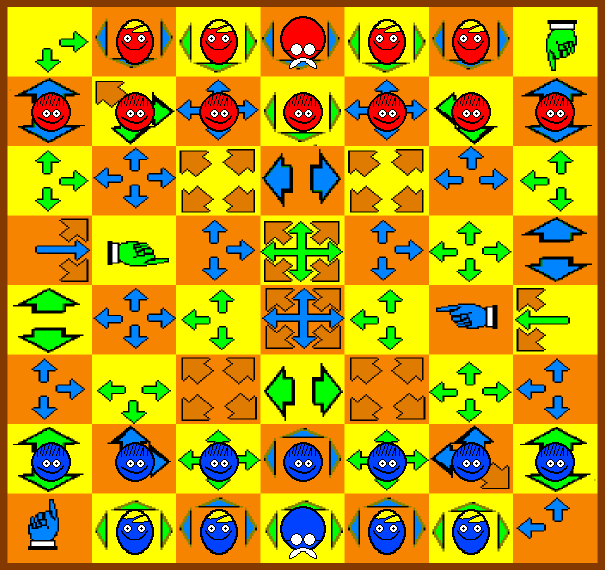College Mess
College Mess is a variant of mine based on the venerable board game of Smess, which was intended as a parody of chess, but which then proved to be an interesting game for adults as well as children. Smess was created by sit-com writer Perry Grant, and was produced in 1970 by Parker Brothers. A game of College Mess can be played using a Smess board and a full set of its pieces. I recall playing exactly one game of Smess as a child, though I recently played through one of the finished Smess games on Game Courier, and that suggested to me that a game of Smess might be significantly longer than a game of chess on average, in terms of the number of moves played. Thus, I thought I might try to come up with some rule changes in order to produce a variant of Smess that might finish sooner than Smess on average if played, even though I also added some rule changes that may improve a player's defensive possibilities. My original motivation to create another chess variant to display on chessvariants.com was in fact to produce one that in some way combined the children's board game of Snakes & Ladders with chess, and I noticed that Smess comes relatively close already, IMHO. I also noticed that there are four squares marked by hand symbols (as pointers) in Smess, and this gave me an idea as to how to make Smess even a little more like a combination of Snakes & Ladders and chess, again IMHO. Note that for reference, a link about the game of Smess is given in the Notes section further below.
Setup
The setup position for College Mess looks the same as for Smess:
Pieces
College Mess is played using 3 piece types, as in Smess, but there are some differences:

This piece represents a Ninny in Smess, but it is more formally to be known as a "Freshman" in College Mess.
A Freshman may move one square at a time in any direction indicated by the pointers on its square, or it may leap 2 squares in such a direction if it starts its move on its 1st or 2nd rank. Note that there is no rule in College Mess similar to en passant capturing as in chess.

This piece represents a Numskull in Smess, but it is more formally to be known as a "Sophomore" in College Mess.
A Sophomore may move any number of squares in any direction indicated by the pointers on its square, without leaping over any piece, or it may leap 2 squares in such a direction.

This piece represents a Brain in Smess, but it is more formally to be known as a "Professor" in College Mess.
A Professor may move one square at a time in any direction indicated by the pointers on its square. Also, if it has not yet moved, once in a game it may leap any number of squares in such a direction, if it ends its move on its 1st rank, and is not under immediate threat of capture prior to making such a leap (similar to the rule in chess that a king cannot castle if already in check). Otherwise, as with any leap, it may be a capturing move.
Rules
In College Mess, the players (or an arbiter, if any) may decide which colour (Blue or Red) moves first. The object is to capture the opponent's Professor, resulting in immediate victory. Like for chess, this is a turn-based game, in which you move one piece per turn on a checkered board. But unlike chess, the College Mess (or Smess) board has pointers on every square, and these pointers indicate which directions a piece may move. There is a special rule in College Mess. If a player's piece starts its move on a square marked by a hand symbol on it, there can be a choice. That piece may be moved as usual, in the direction that the hand symbol indicates. Alternatively, however, that piece may move to the other square on the board that is marked by a hand symbol of the same colour (i.e. blue or green), if that corresponding square is not occupied by another piece belonging to that player, at which point that piece finishes its move on the corresponding square. When any of a player's Freshmen reaches any of the squares on that player's 8th rank, it promotes to a Sophomore.
Notes
I'd tentatively estimate the relative piece values for College Mess as: Freshman = 1 and Sophomore = 2.25, with a Professor having a fighting value of 1, though it cannot be traded without loss of the game. I'd offer these tentative estimates for the pieces in the game of Smess: Ninny = 1 and Numskull = 2, with a Brain having a fighting value of 1, though it cannot be traded without loss of the game. Here's a link to the game of Smess, as described on chessvariants.com: http://www.chessvariants.com/other.dir/smess.html This 'user submitted' page is a collaboration between the posting user and the Chess Variant Pages. Registered contributors to the Chess Variant Pages have the ability to post their own works, subject to review and editing by the Chess Variant Pages Editorial Staff.
This 'user submitted' page is a collaboration between the posting user and the Chess Variant Pages. Registered contributors to the Chess Variant Pages have the ability to post their own works, subject to review and editing by the Chess Variant Pages Editorial Staff.
By Kevin Pacey.
Last revised by Kevin Pacey.
Web page created: 2016-01-24. Web page last updated: 2016-01-24
